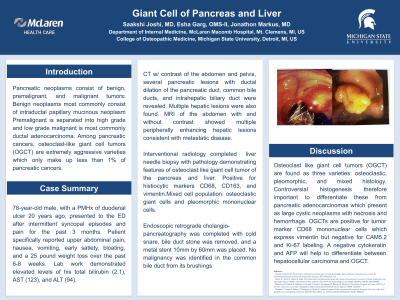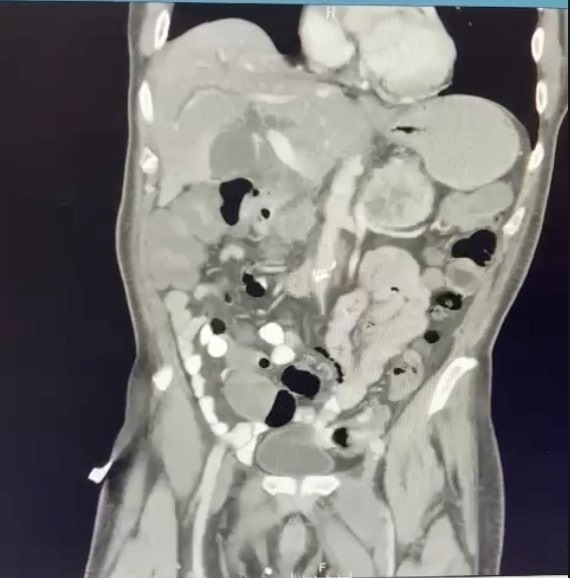Tuesday Poster Session
Category: Biliary/Pancreas
P2978 - Giant Cell of Pancreas and Liver
Tuesday, October 24, 2023
10:30 AM - 4:00 PM PT
Location: Exhibit Hall

Has Audio

Saakshi Joshi, MD
McLaren Macomb
Mount Clemens, MI
Presenting Author(s)
Saakshi Joshi, MD, Jonathan Markus, MD, Jesus Figueroa, MD
McLaren Macomb, Macomb, MI
Introduction: Due to the limited research and guidelines, we present a rare case of osteoclast giant cell tumor of the pancreas and liver.
Case Description/Methods: 78 year old male, initially with no past medical history, presented to the ED after syncopal episode. Of note, the patient had reported for the past 6 to 8 weeks, he experienced upper abdominal pain, nausea, vomiting, early satiety, bloating and a 25 pound weight loss. Upon imaging, computed tomography of the abdomen pelvis with contrast revealed several pancreatic lesions with ductal dilation of the pancreatic duct and common bile duct, hepatic lesions. Magnetic resonance imaging of abdomen subsequently showed multiple peripherally enhancing hepatic lesions most consistent with metastatic disease, large 8.2 cm expansile pancreatic body/tail mass, proximal pancreatic ductal dilation along with focal pancreatic atrophy, cholelithiasis, 3.2 cm heterogeneous pancreatic head mass which surrounds the common and pancreatic duct. During admission, Endoscopic retrograde cholangiopancreatography with cold snare completed, removal of protruding bile duct stone, sphincterotomy, and brushing to rule out malignancy; bile duct stone was removed and a metal stent 10mm by 60mm placed. Liver biopsy demonstrated features of osteoclast-like giant cell tumor of the pancreas and liver, positive for histiocytic markers CD68, CD 163 and vimentin. Morphologically composed of a mixed cell population of predominant osteoclastic giant cells and intermixed pleomorphic mononuclear cells.
Discussion: Both giant cell osteoclast tumors of pancreas and liver are very rare. World health organization groups three types of osteoclast tumors of the pancreas into one classification, referred to as undifferentiated carcinoma of pancreas with osteoclast-like giant cells (UC-OGC). This carcinoma accounts for less than one percent of all pancreatic malignancies.¹ They usually present at an advanced stage and have poor prognosis. There is very little literature on giant cell osteoclast tumors of the liver, therefore no guidelines pertaining to this condition. Due to the rarity of such tumors, it is extremely important to document such cases to further establish guidelines and information regarding the condition.
Osteoclastic giant cell tumor of the pancreas. Temesgen WM, Wachtel M, Dissanaike S. Int J Surg Case Rep. 2014;1:175–179.

Disclosures:
Saakshi Joshi, MD, Jonathan Markus, MD, Jesus Figueroa, MD. P2978 - Giant Cell of Pancreas and Liver, ACG 2023 Annual Scientific Meeting Abstracts. Vancouver, BC, Canada: American College of Gastroenterology.
McLaren Macomb, Macomb, MI
Introduction: Due to the limited research and guidelines, we present a rare case of osteoclast giant cell tumor of the pancreas and liver.
Case Description/Methods: 78 year old male, initially with no past medical history, presented to the ED after syncopal episode. Of note, the patient had reported for the past 6 to 8 weeks, he experienced upper abdominal pain, nausea, vomiting, early satiety, bloating and a 25 pound weight loss. Upon imaging, computed tomography of the abdomen pelvis with contrast revealed several pancreatic lesions with ductal dilation of the pancreatic duct and common bile duct, hepatic lesions. Magnetic resonance imaging of abdomen subsequently showed multiple peripherally enhancing hepatic lesions most consistent with metastatic disease, large 8.2 cm expansile pancreatic body/tail mass, proximal pancreatic ductal dilation along with focal pancreatic atrophy, cholelithiasis, 3.2 cm heterogeneous pancreatic head mass which surrounds the common and pancreatic duct. During admission, Endoscopic retrograde cholangiopancreatography with cold snare completed, removal of protruding bile duct stone, sphincterotomy, and brushing to rule out malignancy; bile duct stone was removed and a metal stent 10mm by 60mm placed. Liver biopsy demonstrated features of osteoclast-like giant cell tumor of the pancreas and liver, positive for histiocytic markers CD68, CD 163 and vimentin. Morphologically composed of a mixed cell population of predominant osteoclastic giant cells and intermixed pleomorphic mononuclear cells.
Discussion: Both giant cell osteoclast tumors of pancreas and liver are very rare. World health organization groups three types of osteoclast tumors of the pancreas into one classification, referred to as undifferentiated carcinoma of pancreas with osteoclast-like giant cells (UC-OGC). This carcinoma accounts for less than one percent of all pancreatic malignancies.¹ They usually present at an advanced stage and have poor prognosis. There is very little literature on giant cell osteoclast tumors of the liver, therefore no guidelines pertaining to this condition. Due to the rarity of such tumors, it is extremely important to document such cases to further establish guidelines and information regarding the condition.
Osteoclastic giant cell tumor of the pancreas. Temesgen WM, Wachtel M, Dissanaike S. Int J Surg Case Rep. 2014;1:175–179.

Figure: Pancreatic mass, splenic congestion and common bile duct
Disclosures:
Saakshi Joshi indicated no relevant financial relationships.
Jonathan Markus indicated no relevant financial relationships.
Jesus Figueroa indicated no relevant financial relationships.
Saakshi Joshi, MD, Jonathan Markus, MD, Jesus Figueroa, MD. P2978 - Giant Cell of Pancreas and Liver, ACG 2023 Annual Scientific Meeting Abstracts. Vancouver, BC, Canada: American College of Gastroenterology.
